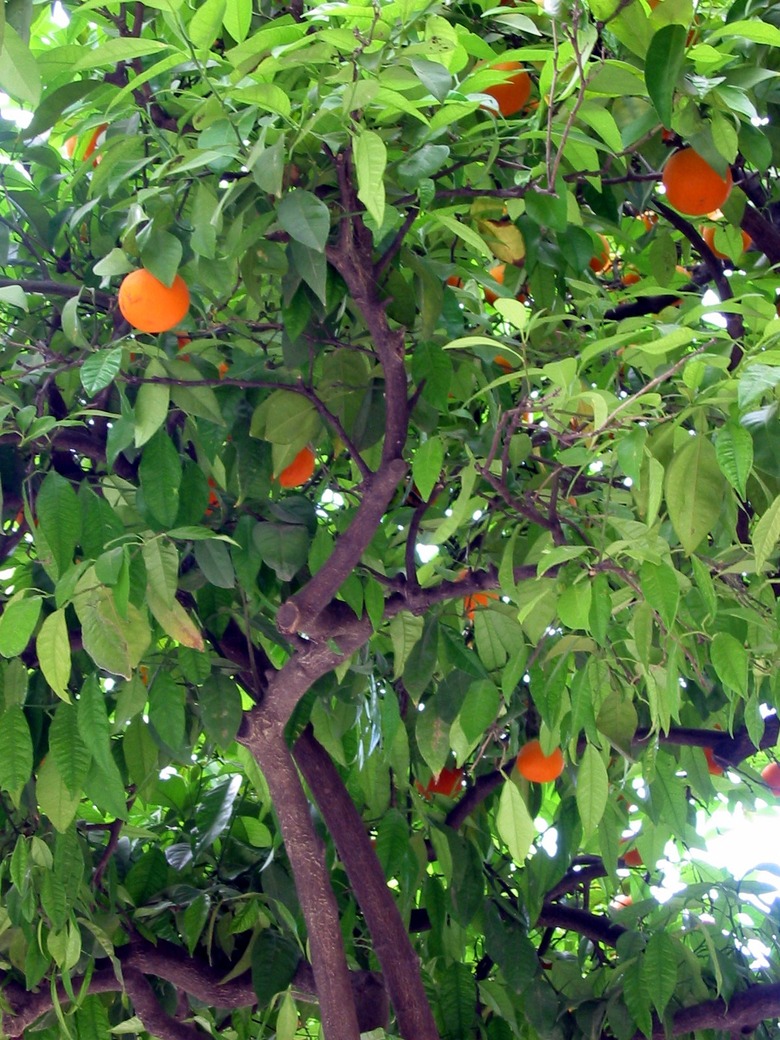How To Protect Orange Trees From Frost
Things Needed
- Water
- Cloth
- Cardboard
- Palm fronds
- Dirt
- Tarp
- Hose
- Christmas lights
- 100-watt outdoor lamp
- Rope
- Blanket
- Sheet
Tip
The critical temperatures where most orange trees will be damaged is anywhere between 25 degrees to 29 degrees.
Warning
Do not prune the orange tree of any dead branches until all signs of frost have passed in the springtime. Many times new growth will appear on branches that you thought were no longer alive. Do not plant your orange tree in the lowest section of your yard. Cold air will move downhill and will be colder in the lowest depressions in your yard.
If you live in the subtropical or tropical regions of our country, protecting your orange trees from frost damage is not always a yearly concern. Orange trees grow best in zones 9 or above and seldom have to weather through frosty conditions. Occasionally, temperatures will dip below the freezing mark and this can be deadly to citrus trees. This is especially true if they remain too cold for too long. Unless your orange tree is in a container you can move inside, you will have to protect your orange tree from freezing.
Step 1
Plant your orange tree on the south side of the house. This will offer the tree some protection from the cold winds coming in from the north. Planting the tree close to a building or structure will also offer some protection from the cold.
- If you live in the subtropical or tropical regions of our country, protecting your orange trees from frost damage is not always a yearly concern.
- Occasionally, temperatures will dip below the freezing mark and this can be deadly to citrus trees.
Step 2
Water your orange tree thoroughly before the freeze sets in. This includes saturating the soil as well as the trees foliage. This will help in keeping the tree hydrated during the freezing temperatures and help it produce heat.
Step 3
Protect the trunk of the orange tree by either wrapping it with cloth, cardboard, or palm fronds to insulate it and help keep it warm. Wrap the tree's entire trunk section up to the tree's main branches. You can also mound dirt around the entire trunk. Be cautious when removing the dirt so you don't damage the tree's bark.
- Water your orange tree thoroughly before the freeze sets in.
- Be cautious when removing the dirt so you don't damage the tree's bark.
Step 4
Place a hose at the base of the tree and allow it to trickle water over the root system during the night. The water will give off heat and help protect it from frost damage.
Step 5
Wrap the top portion of the tree with a tarp, blanket or sheet, to protect the orange tree's foliage. Remove the covering once daylight has struck. You will probably need to tie the covering onto the tree or stake it down to keep it in place.
Step 6
Hang Christmas lights over the entire tree. They will emit a constant supply of warmth to the tree during the night when temperatures will be at their worse. You can also place a 100-watt outdoor lamp underneath any coverings to keep the tree warm.
- Place a hose at the base of the tree and allow it to trickle water over the root system during the night.
- Wrap the top portion of the tree with a tarp, blanket or sheet, to protect the orange tree's foliage.
Step 7
Remove any mulch or other soil coverings you have placed around the base of the tree. The bare soil will generate more heat than if it was covered with a ground cover.
